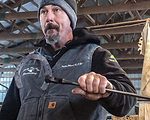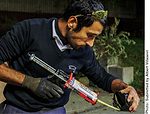Advertise Follow Us
Equipment
Badass Rigs & Trailers
Texas horseshoer Don Mock hauls a slick, functional trailer that was built by teenage brothers as a school project
Read More
Online Hoof-Care Classrooms
Introduction to Lameness Measurement for Professional Farriers
Read MoreA Shoe Fit for a Farrier
Conformation is an important consideration when choosing equine and human footwear
Read More
Badass Rigs & Trailers
Small Trailer Adds to Career Longevity
Using smaller trailers has saved wear and tear to lengthen Indiana farrier’s shoeing career
Read More
Steps to Make a High Scoring Square Toe Horseshoe
Master shoe modifications before taking the certified farrier exam
Read More
Tips for Drilling and Tapping Horseshoes
Save time and money by employing better practices in a deceptively difficult approach
Read More
How to be Successful When Using Hoof Boots
Knowledge of alternative footgear options will expand a hoof-care professional’s toolbox
Read More















